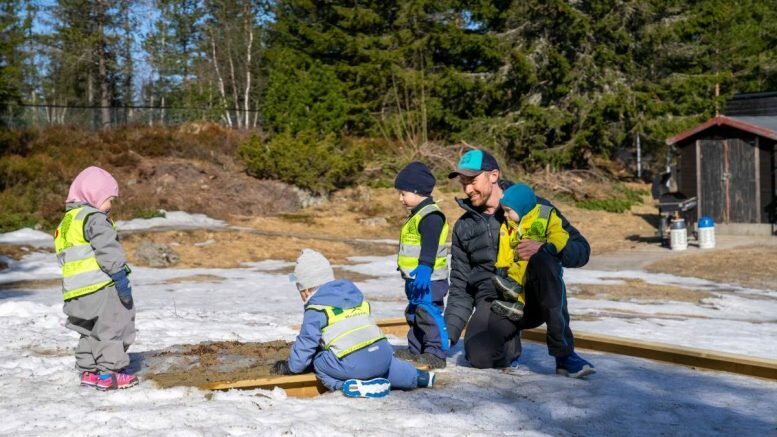Research conducted by the University of Stavanger (among others) has highlighted that Norway’s enriched natural environment and integration of nature-based activity should contribute greatly to the development of children into fully-fledged environmental stewards. This is also likely to contribute to Norway’s holistic position as the ideal country to provide good living conditions for children.
Norway and Australia; two peas in a pod
The basis of the research was to ascertain what comprehension of, and attachment to nature was held by early stages preschool children. This included attempting to gauge how they perceived associated subjects, like recycling. This was achieved through the interviewing of children.
Australia and Norway were naturally useful bedfellows for comparison: both countries are host to enormous landmass, vast natural landscapes, and an emphasis on a lifestyle that incorporates activity and the outdoors. But, both countries also have stark differences: they form entirely different continents, with different cultures, and so this acts as a sort of “control” on the comparison, rather than say comparing Norway and Sweden, which will probably hold broadly overlapping values, due to shared history.
For Norway’s part, the analysis took place in a kindergarten in Rogaland, and for Australia, in Queensland. All of the children interviewed were between 4-5 years old.
The respective cohorts of children were interviewed on several interrelated components of environmentalism. These were;
- Being outside in nature
- Recycling and conservation
- Gardening use and composting
Being outside in nature: Curiosity and agency
The researchers asked basic questions, like “do you like being outside in nature?”, and then encouraged the children to elaborate on their answers. Whilst encouraged, the children were given minimal prompting, so as to garner responses as faithful to the children’s thoughts as possible.
The children mostly felt that both their parents and other adults in their company enjoyed being outside. While some of the Norwegian children asked did not enjoy being outside, this was due to factors such as being cold, or having “sore feet from walking”, not as an opposition to being outside in general. Of those children that didn’t like to be outside, they mentioned favorable alternatives such as going to the beach, or to museums: activities that still contain overlap with exposure to natural sciences and the environment.
Of the children that did favor being outside, the reasons that were cited were predominantly the chance to interact with animals and play with friends in a “free” setting. Excitement regarding animal encounters and the chance to socialize with friends was also mentioned by those who preferred alternatives.
When asked for their favorite activities, the children gave mixed answers that included playing in trees, playing on the beach, and engaging in a range of art-and-craft-based activities. All of these sentiments were basically mirrored in the Australian element of the study. However, unlike the Norwegian children, the children down under mentioned that they enjoyed specific functional activities like recycling and watering plants.
Recycling and conservation: A technical perspective
The children in both cohorts were asked, “do you know what rubbish is?”. The Norwegian children mostly knew what rubbish was. With great stereotypical childlike innocence, it was suggested that rubbish was, “things that go in the bin”, or that “the removal van takes away to the machine”.
However, perhaps the most encouraging answers were those given by children that suggested that rubbish is something that is harmful to nature, and one little boy in particular contemplated that rubbish is “something which animals cannot accept… fishes does not bear plastics.”
Whilst the Norwegian children displayed a sense of philosophical empathy with our woodland and sea-faring neighbors, the Australian children displayed a more technical sense of understanding – highlighting various categories of rubbish, whilst making an inherent link to the process of recycling.
This slight difference in attitude was re-iterated when the children were questioned on their recycling practices. As before, the Norwegian children alluded to vague levels of participation, whereas the Australians seemed to have a more concrete understanding of both process, and environmental ramification.
Both sets of children related energy conservation from either very immediate consequences like having energy for hot showers or use of an iPad, to far-reaching consequences like running out of water in the ocean or not being able to pay bills – there wasn’t the same sense of intermediate perspective as with outdoor play and excursion into nature.
Gardening use and compost: Little green fingers
While the Norwegian children seemed to broadly enjoy elements of gardening and composting, such as plant watering and seeding; some children attending the same kindergarten answered differently as to whether their kindergarten actually had this facility.
While this can be forgiven in a study of 4-5 year-olds, it does suggest that perhaps children of that age are not completely reliable in communicating how they perceive their interactions with their surroundings. That being said, it is not specified how many occurrences there were of such contradictory answers.
As mentioned, the enjoyment of gardening activity was generally enjoyed. The Australians seemed to be slightly more technically astute than the Norwegian children, mentioning the sequential processes of gardening: digging, seeding, watering, and even collecting a harvest – including cultivating eggs from chickens.
This knowledge disparity also extended to an insight into the nature and purpose of compost, with the Australians understanding it as beneficial to plants, and also as a home to worms as part of an ecosystem. Only 3 out of the 20 Norwegian children asked knew what was meant by “compost”. One important factor to remember is that Australia is far more suited to gardening on a yearly basis, whereas Norwegian gardening opportunities are seasonally dictated.
What can we learn from Rogaland?
It seems clear that the majority of both groups of children enjoyed being outdoors, and also enjoyed naturalistic alternatives like art-and-craft activities.
The study paints a picture that for all of this similarity, the Australian children had a greater understanding of certain technical aspects of how such activity connects to the issues of sustainability within the environment. However, it should also be noted that this may well be deliberate.
It could be that the Australian model of pre-schooling places these aspects more firmly as an agenda due to Australia’s temperamental and volatile climate, with the Norwegian model more likely to emphasize the comfort and security of the child as primary, and an environmental understanding coming organically through osmosis, both from the natural surroundings and from curiosity.
What is absolutely clear, is that children’s knowledge of the environment can be guided by their school curriculum, or by their own curiosity in secure surroundings. It should not be forgotten that a few of the children did not like being outside, and so perhaps an agenda-driven model isn’t best for total inclusivity.
Instead, having vast natural surroundings, and the freedom to explore them is likely the best model for environmental involvement. In this sense, Norway is perfectly placed. As a country, it possesses these natural arenas, and with a population often immersed in outdoor activity, it seems that this may be a perfect place to raise children for the environmentally conscious.
Finally, as relates to the various questions it seems apparent that children’s sophistication in comprehension may diminish somewhat (at 4-5 years old) with the introduction of “heavy” environmental consequences. It is always refreshing to remember that children are children, and a happy child is an inquisitive child.
Perhaps the best model for cultivating future environmental stewards is to give them free rein to engage in the more fun, sensory and visceral activities on their doorsteps, and leave broader ecological questions to the adults – until, that is, the children ask.
Study Name: ‘Children’s Understandings of Environmental and Sustainability-related Issues in Kindergartens in Rogaland, Norway, and Queensland, Australia’
Study Authors: Barbara Maria Sageidet , Mia Christensen , Julie M. Davis
The opinions expressed are those of the author and are not held by Norway Today unless specifically stated.
Source: #Norway Today / #NorwayTodayNews
Do you have a news tip for Norway Today? We want to hear it. Get in touch at [email protected]






A enjoyable insight – love the author’s style. In Scotland, there is a current emphasis on Outdoor Play, given the benefits to health and well-being and to train our future ecologists. There are obvious similarities between Scotland and Norway in terms of opportunities being dictated by weather! However, we buy rain jackets and welly boots so that our wee children go out and experience all weathers!
A enjoyable insight – love the author’s style. In Scotland, there is a current emphasis on Outdoor Play, given the benefits to health and well-being and to train our future ecologists. There are obvious similarities between Scotland and Norway in terms of opportunities being dictated by weather! However, we buy rain jackets and welly boots so that our wee children go out and experience all weathers!
This is the fact that Norway can be proud of. Education and putting the preach into practice is what other countries should envy. Norway is so clean, tidy. Congrats, Norwegians!